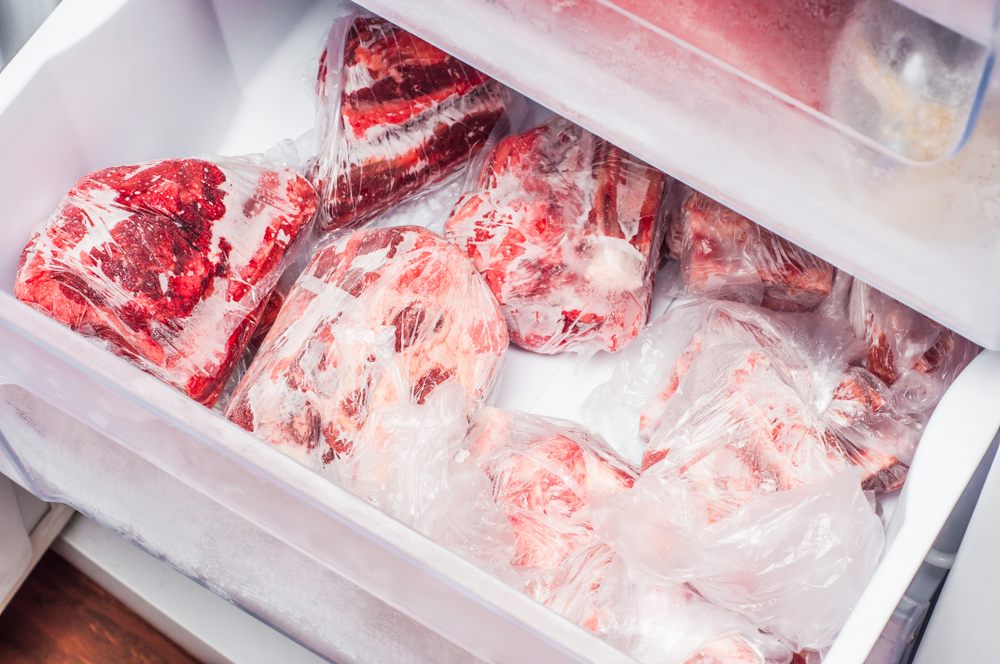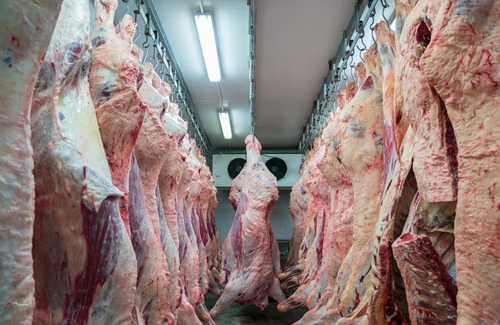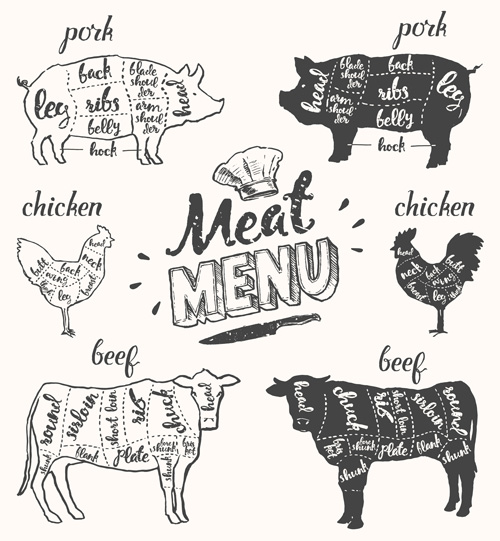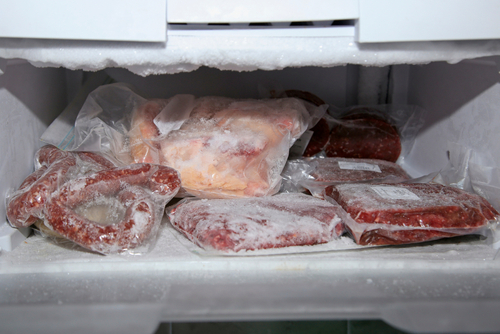Do you want to fill your freezer with meat from a local farmer? Are you looking for a way to get fresher meat, without the work of raising your own?
If you answered yes, purchasing a whole animal for your freezer can be a great decision.
But, buying meat this way isn’t for everyone. You wind up with an assortment of cuts, not just the popular ones. And though it often saves money on a pound for pound basis, you must be able to pay upfront.
To help guide you through this decision, here’s an overview of what you can expect when you purchase meat this way.
Benefits of Purchasing a Whole Animal from a Farmer
Let’s start off with some of the perks. Here are five of the best benefits of purchasing a whole animal from a farmer.
- It’ll save money in the long run
- You support the local economy
- You can often visit the farm to see how the animal was raised
- There’s no pink slime or any other weird additives to worry about
- You can opt to have the meat packaged in sizes appropriate for your family’s needs
Understanding the Fees
If you’re excited by the benefits, it’s time to find farmers in your area. Some will have websites. Others may post in the classifieds or advertise strictly by word of mouth. Ask around and see what you can find.
As you begin comparing costs, there are some important fees to be aware of.
Kill Fee: It costs money to kill the animal. Most places will charge a kill fee to cover this cost. In my area, it’s $90 for a cow and $70 for a smaller animal like a sheep or pig.
Cost per Pound Hanging Weight: You’ll need to pay the famer for the animal. Most have a per-pound price. This will typically be on hanging weight (the weight after slaughter, but before processing.)
Hanging weight is not how much meat you’ll get.
Cut and Wrap: Once you’ve paid the farmer for the animal, you’ll need to pay the butcher shop for cutting and wrapping. This is the job of taking the carcass, breaking it down into recognizable cuts, and wrapping it for the freezer.
Most butcher shops have a price per pound for this. If you’re purchasing a pig, you will pay a higher price on the smoked meat like bacon and ham.
Check with your farmer for the exact structure. Some charge more per pound, but that includes cut and wrap. Just make sure you what fees you will need to pay. You don’t need any unexpected surprises.
How Much Will It Cost?
On a pound for pound basis, you save a lot of money purchasing a whole animal. You wind up getting steaks and roasts for the same price as ground beef. That’s because you pay one set fee per pound for the whole animal.
You need to make sure you calculate the total price. Add up all your fees. Ask your farmer for an approximate weight of the animal.
The economy in your area will play a factor in how much the meat costs. So will the type of meat (grass-fed and organic go for more).
If you pay $3/pound to the farmer and $1.25 to the butcher, you can calculate your costs at $4.25/pound. Then you’d need to add in your kill fee to get a better final estimate.
A whole beef can run you more than $2000. If you aren’t used to buying your meat in bulk, you may get sticker shock.
The good news? This meat can last a year in the freezer. You won’t need to buy meat for a long time. So you can take the money you save each month and put it into savings so you’re ready to purchase your next one.
How Much Meat?
So exactly how much meat will you be taking home? It depends on what you purchase. Cows, pigs, and sheep all weigh indifferently. You also need to factor in the breed that you’re buying: a Dexter cow is significantly smaller than a Holstein.
You can expect to take home about 70% of a hog’s hanging weight. This drops to roughly 60% for a cow, and 50% for a sheep.
From a pig, you usually take home about 120 pounds of pork. A typical whole cow will get you nearly 500 pounds of beef. If you purchase a sheep, you can expect around 50 pounds.
Many farmers also give you the option of purchasing sides. If you don’t have room (or funds) to purchase a whole animal, you can purchase a half or a quarter. In this case, you’ll need to adjust your calculations accordingly.
Make sure you’ve accounted for freezer space before bringing the animal home. If you’re purchasing a whole animal, it won’t fit in your freezer above the fridge.
About half of the meat you take home will be ground. The rest will be a combination of steaks, roasts, and other cuts.
Talking to the Butcher
Once you’ve arranged to purchase an animal, the farmer will arrange for its slaughter. When the carcass arrives at the butcher, they’ll hang it for the appropriate amount of time.
The butcher I work with calls each buyer to get cut instructions. I’ve heard that others just stick to a standard cut list, so ask your farmer what you can expect.
When the butcher calls, they ask basic questions about how you’d like your meat packaged. Here are some of the questions they may ask:
- How many chops/steaks in a package? (2 is standard, but I opt for 4 because of my family size.)
- How thick of a cut for steaks/chops/bacon? (3/4 inch or 1 inch are common)
- Do you want to keep the liver/tongue/other organ meat?
- Do you want the bones? (There’s usually dog bones and soup bones.)
- How do you want your sausage flavored? (For a pig.)
- Do you want stew meat?
- How much meat do you want in a package? (1 pound is standard.)
- Do you want the fat? (Pig fat can be used to make lard.)
- Do you want any meat tenderized?
There also may be some specific questions about cuts. For instance, you can have the rib roast cut into rib steaks.
As you answer, your butcher will be taking notes. This way they can get everything just how you want it.
If you have questions about the process, just ask. And if there’s something you aren’t sure you’ll use, you can always ask to have it ground.
Picking Up Your Meat
After the butcher has cut your animal to your specifications, they’ll wrap it and freeze it. When it’s frozen completely, you’ll get a call to come to pick it up. Your meat will take quite a bit of space, so plan accordingly.
I always bring several boxes with me in the back of the Suburban. Then as I unload from the butcher crates into my boxes, I can sort it how I want it.
If you have a long drive, plan on bringing coolers. You don’t want your meat to thaw before you get it in your freezer.
How to Use Different Cuts
I love the variety of buying a whole animal brings. But, it took some getting used to. There are several cuts of meat you may not be as familiar with.
You’re getting all the animal, not just the prime cuts. This is a sustainable way to eat, as you’re using the whole animal and not just a couple of pieces of it. After all, there aren’t that many porterhouse steaks on a cow.
When you come across a cut you’re wondering about, start with Google. Try to learn where on the animal the meat came from, and the best way to cook it.
Many cuts need slow cooking to help make them tender. These work well in the crockpot or a Dutch oven. Steaks can be marinated and grilled to help keep them tender.
The Instant Pot is another option for many cuts, especially if you’re short on time.
There are many different methods and recipes out there, so keep trying until you find one you like.
Don’t be afraid to try new things. You never know, you may discover that the hanger steak is a new family favorite.
Do You Purchase a Whole Animal for Your Freezer?
If you also purchase your meat this way, what tips would you give a newbie? Is there anything you wish you would have known before you made your first purchase? Share your thoughts in the comments.
















































































We grow our own beef and yes, have it processed at a professional processor.
First, I would say, please make sure the meat processor you choose has a good reputation of being honest! It is very easy to get ripped off, several different ways!!
We have our cows DNA tested before slaughter then after processing we have the beef tested again. It is worth the cost/price.
Second, a 700 pound cow will produce 420+ pounds of beef. We end up with about 140 – one pound packages of hamburger beef and about 100 packages of different cuts of beef including speciality cuts like standing prime rib roasts, round steaks – tenderized, liver, ribs and soup bones.
At first, to figure out the cuts of meat and the number of packages for each cut we needed, I went thru all our recipes, made a list, then multiplied by the number of times cooked in a month, times 12.
We grill steaks often so, those cuts take priority. From there, I use round steaks for several different recipes so, I order all those they can cut; usually about 24-30.
Since ALL the beef cuts will be divided amongst at least two freezers have a plan on which cuts will go where?
We have four freezers, two in the house and two in the garage. I mostly divide mine by shelves except the hamburger.
Here goes. My two freezers inside are different. The small, refrigerator freezer I do not put meat in. I leave it open for ‘other frozen foods.’
The Inside house, upright freezer, I fill it almost full of the cuts we use the most! In the lower drawers I fill them both full of the hamburger packages, which usually holds about 80. I do leave room for other frozen foods there too but, very little.
In the outside refrigerator freezer, I store the soup bones and beef liver, then leave the rest for other frozen foods there too.
The outside upright freezer holds the other half of the beef including the extra 60 packages of hamburger in the bottom drawers. I store the ribs on the door shelves along with the stew meat.
Third, if you are shopping to buy a new freezer, try to buy one that locks. It is comforting to know such a large investment is secure from leaving a door unlocked / open or from being pilfered!
Finally, at this writing, January 2021 – freezers are on back order for 6-8 months or LONGER so, please make sure you have your storage secure before you order and/or purchase your meat!!!
You do not want to have to pay to store your meat. In our area, most processors charge $1 per pound per WEEK as they are not in business to store your meat, so plan accordingly!!! Hope this has been helpful. God bless.
My father used to buy a side of beef or a quarter of a cow at a time. We had a large standing freezer, and the side of beef left enough room for ice cream and TV dinners. The rest was beef. My mother was a talented cook. We learned about all sorts of different types of cuts. She did it up well enough, that we even liked liver. It was a money saver, and we seemed never to run out of hamburger. If you’ve never purchased meat this way, you might want to start with a side or a quarter. If you have a large enough family to feed, and the quarter or side does a good job for you … then perhaps you’ll graduate to buying a whole critter.
There was one time that Dad bought a ton of beef jerky. It started out well enough – my friends liked to come over and enjoy beef jerky, and it was great on Boy Scout campouts. However, about five or six months in, most of the lot started suffering from freezer burn. He never bought jerky in the same quantity again.
I’ve enjoyed reading this, is such an informative way. I think we may give it a try in the Spring. Thank you,
Great Article, With eight kids and a farm WHERE, OH WHERE do you find time to write! We butchered a large hog 375# range (had to wait for it to get cold enough) from pasture to canner and freezer last Saturday. We’d even take a break to sneak in for a bite of sausage while it was being cooked for canning (SO AWESOME)!. As for doing a pig or other meat canning is also a great way to go, especially with the freezer freez-up! (back ordered). Meat will last several years canned and no freezer burn. Along with freezers, be aware that canning supplies are also being pressured! (punn intended) As mentioned be sure you have your storage planned. We had over a hundred jars of sausage. Again, great article, THANKS!
I’ve enjoyed reading this, is such an informative way. I think we may give it a try in the summers. Thank you,